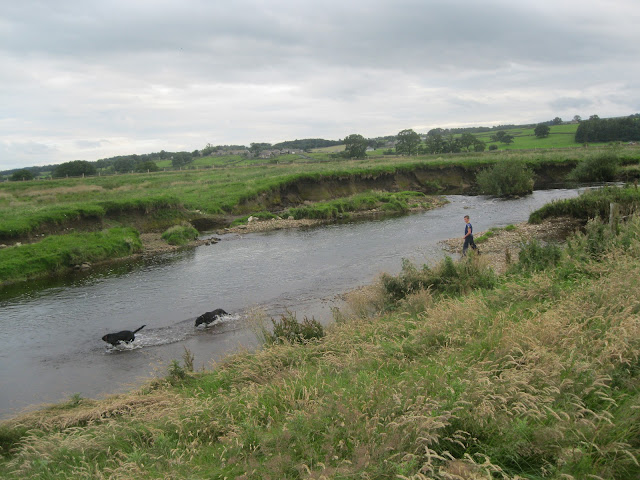This area often floods in winder and is good for waders. The Long Preston Deeps project is to increase the bird life, and now 9 of the farmers in the area are in involved in the scheme and get or are applying for Higher Level Stewardship money to enable them to farm the land in certain ways to allow this.
This year however (with the Jet stream our of place) the river flooded three times in summer - and the waders lost their nests and eggs.
The sand martins in the river bank are now having a third attempt at breeding this year.
The flood banks prevent the river overflowing (normally) but streams flowing into the Ribble "back up" and can flood the land.
The ? Environment Agency used to mend the flood banks. with cut backs they have stopped doing this. However this project means that new banks will be built - so at least for now the banks will hold!
 Long Preston Deeps Catchment Appraisal Tour Mon 23rd July
Long Preston Deeps Catchment Appraisal Tour Mon 23rd JulyThe Ribble Rivers Trust organised a walk meeting along the Ribble tonight. The invitation said:-
"Join us on a short walk to discuss the challenges and opportunities for managing this part of the Ribble catchment and to learn more about the work
already undertaken, and being planned as part of the Long Preston Deeps SSSI River Restoration project."
And that's what we did. Fascinating.
Here is Jack of the Ribble Rivers Trust explaining how the flood defence bank at this point has been moved back. 3 foot lengths of willow branch were planted in the ground in April and have now produced roots and shoots.
 The flood defence bank has been moved "inland" and the 20m or so strip of bank which will now be covered with water when the river floods has been planted with trees - mostly ash, rowan, alder, oak and willow.
The flood defence bank has been moved "inland" and the 20m or so strip of bank which will now be covered with water when the river floods has been planted with trees - mostly ash, rowan, alder, oak and willow.Jack explained to that when tree branches, or tree roots stick out into the river it reduces the flow and causes eddies, and sheltered areas behind the obstruction. Tiny river creatures and consequently larger fish like to stay in these sheltered places..
 So the tree roots beside the river bind the river bank. They are good for wildlife. they increase the number of fish. The trees don't have to be large - they can be coppiced or pollarded
So the tree roots beside the river bind the river bank. They are good for wildlife. they increase the number of fish. The trees don't have to be large - they can be coppiced or pollardedIn the picture below the flood bank once ran at the water's edge. Now it has been moved 20m back and trees planted on some of the area. You can see (almost centre) where a channel has been cut which fills with water when the river is flooded.

Here you can see where the old bank has been cut. It is made out of glacial gravels.
The two dogs fetch the ball thrown in the water. The sand martins nest in the banks


No comments:
Post a Comment